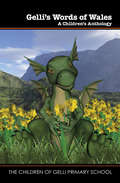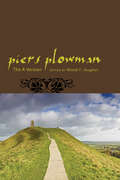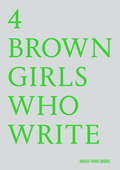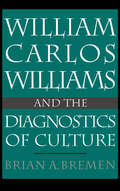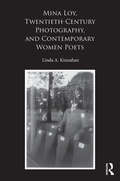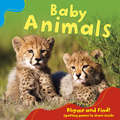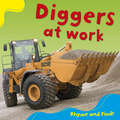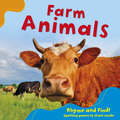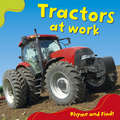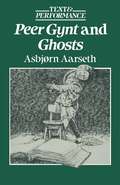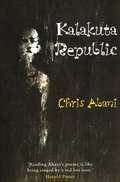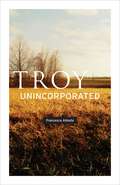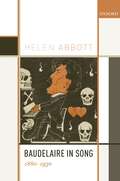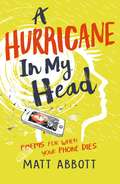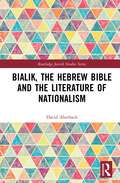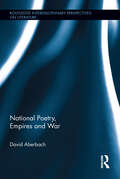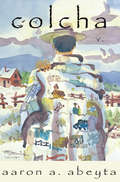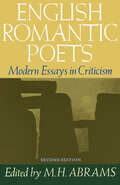- Table View
- List View
Gelli's Words of Wales: A Children's Anthology (Wordcatcher Modern Poetry)
byAs part of our Eisteddfod celebrations, we worked with poet Francesca Kay and author Chris Lynch to develop our writing skills. We are so proud of our writing we decided to publish our work. We all had the opportunity to write in different styles and used different story or poem formats and then chose the work we would like to be published. We hope you enjoy reading our work as much as we enjoyed writing it! A book full of creative, funny and enjoyable poems and stories created by the cheerful and creative kids of Gelli Primary to celebrate all things Welsh.
Piers Plowman: The A Version
by Mí 267 Eál F. VaughanThe fourteenth-century Piers Plowman is one of the most influential poems from the Age of Chaucer. Following the character Will on his quest for the true Christian life, the three dream narratives that make up this work address a number of pressing political, social, moral, and educational issues of the late Middle Ages. Míceál F. Vaughan presents a fresh edition of the A version, an earlier and shorter version of this great work.Unlike the B and C versions, there is no modern, affordable edition of the A version available. For the first time in decades, students and scholars of medieval literature now have access to this important work. Vaughan’s clean, uncluttered text is accompanied by ample glossing of difficult Middle English words. An expansive introduction, which includes a narrative summary of the poem, textual notes, detailed endnotes, and a select bibliography frame the text, making this edition ideal for classroom use.This is the first classroom edition of the A version since Thomas A. Knott and David C. Fowler’s celebrated 1952 publication. Based on an early-fifteenth-century manuscript from the University of Oxford’s Bodleian Library, Vaughan’s text offers a unique rendition of the poem, and it is the first modern edition not to attribute the poem to William Langland. By conservatively editing one important witness of Piers Plowman, Vaughan takes a new generation of students to an early version of this great medieval poem.
4 BROWN GIRLS WHO WRITE
by 4 BROWN GIRLS WHO WRITE Roshni Goyate Sharan Hunjan Sheena PatelRoshni Goyate, Sharan Hunjan, Sheena Patel and Sunnah Khan are four writers that make up the talented collective 4 BROWN GIRLS WHO WRITE and bring their radical, polyphonic performance style to bear on a series of individual pamphlets that still resonate with their collaborative force. Each author’s discreet publication is a stand-alone work, published as a set of poetry and prose pamphlets, highlighting the daring, brilliant writing that characterises both the group and each individual author.
William Carlos Williams And The Diagnostics Of Culture
by Brian Bremen A.Bremen's study examines the development of William Carlos Williams's poetics, focusing in particular on Williams's ongoing fascination with the effects of poetry and prose, and his life-long friendship with Kenneth Burke. Using a framework based on Burke's and Williams's theoretical writings and correspondence, as well as on the work of contemporary cultural critics, Bremen looks closely at how Williams's poetic strategies are intimately tied to his medical practice, incorporating a form of methodological empiricism that extends his diagnoses beyond the individual to include both language and community. The book develops a series of rhetorical, cognitive, medical, and political analogues that clarify the poetic and cultural achievements Williams hoped to realize in his writing.
Mina Loy, Twentieth-Century Photography, and Contemporary Women Poets
by Linda A. KinnahanIn Mina Loy, Twentieth-Century Photography, and Contemporary Women Poets, Linda A. Kinnahan explores the making of Mina Loy’s late modernist poetics in relation to photography’s ascendance, by the mid-twentieth century, as a distinctively modern force shaping representation and perception. As photography develops over the course of the century as an art form, social tool, and cultural force, Loy’s relationship to a range of photographic cultures emerging in the first half of the twentieth century suggests how we might understand not only the intriguing work of this poet, but also the shaping impact of photography and new technologies of vision upon modernist poetics. Framing Loy’s encounters with photography through intersections of portraiture, Surrealism, fashion, documentary, and photojournalism, Kinnahan draws correspondences between Loy’s late poetry and visual discourses of the body, urban poverty, and war, discerning how a visual rhetoric of gender often underlies these mappings and connections. In her final chapter, Kinnahan examines two contemporary poets who directly engage the camera’s modern impact –Kathleen Fraser and Caroline Bergvall – to explore the questions posed in their work about the particular relation of the camera, the photographic image, and the construction of gender in the late twentieth century.
Mina Loy, Twentieth-Century Photography, and Contemporary Women Poets
by Linda A. KinnahanIn Mina Loy, Twentieth-Century Photography, and Contemporary Women Poets, Linda A. Kinnahan explores the making of Mina Loy’s late modernist poetics in relation to photography’s ascendance, by the mid-twentieth century, as a distinctively modern force shaping representation and perception. As photography develops over the course of the century as an art form, social tool, and cultural force, Loy’s relationship to a range of photographic cultures emerging in the first half of the twentieth century suggests how we might understand not only the intriguing work of this poet, but also the shaping impact of photography and new technologies of vision upon modernist poetics. Framing Loy’s encounters with photography through intersections of portraiture, Surrealism, fashion, documentary, and photojournalism, Kinnahan draws correspondences between Loy’s late poetry and visual discourses of the body, urban poverty, and war, discerning how a visual rhetoric of gender often underlies these mappings and connections. In her final chapter, Kinnahan examines two contemporary poets who directly engage the camera’s modern impact –Kathleen Fraser and Caroline Bergvall – to explore the questions posed in their work about the particular relation of the camera, the photographic image, and the construction of gender in the late twentieth century.
Baby Animals: Baby Animals (Rhyme and Find)
by M A PalmerRhyme and Find board books offer a unique combination of big bold photographs and fun read aloud rhyming text, plus a spot and find panel on each page, perfect for adults and children to share and enjoy. A picture activity at the back brings an extra visual treat!
Diggers at Work: Diggers At Work (Rhyme and Find)
by M A PalmerRhyme and Find board books offer a unique combination of big bold photographs and fun read aloud rhyming text, plus a spot and find panel on each page, perfect for adults and children to share and enjoy. A picture activity at the back brings an extra visual treat!
Farm Animals: Farm Animals (Rhyme and Find)
by M A PalmerRhyme and Find board books offer a unique combination of big bold photographs and fun read aloud rhyming text, plus a spot and find panel on each page, perfect for adults and children to share and enjoy. A picture activity at the back brings an extra visual treat!
Tractors at Work: Tractors At Work (Rhyme and Find)
by M A PalmerRhyme and Find board books offer a unique combination of big bold photographs and fun read aloud rhyming text, plus a spot and find panel on each page, perfect for adults and children to share and enjoy. A picture activity at the back brings an extra visual treat!
Peer Gynt and Ghosts: Text and Performance (Text and Performance)
by Asbjorn AarsethA study of two of Henrik Ibsen's most impressive and frequently- performed dramatic texts, the dramatic poem Peer Gynt and the concentrated prose play Ghosts, whose appearance caused an uproar when first performed. In the first half of the book, the author pays particular attention to the imagery patterns of Ibsen's language; Peer Gynt is considered in its cultural context, and Ghosts with reference to Ibsen's concept of drama. Recent productions of both plays are considered in detail, including the Young Vic production of Ghosts in 1986.
Kalakuta Republic
by Chris AbaniThis powerful collection of poems details the harrowing experiences endured by Abani and other political prisoners at the hands of Nigeria's military regime in the late 1980s. Abani vividly describes the characters that peopled this dark world, from prison inmates such as John James, tortured to death at the age of fourteen, to the general overseers. First published after his release from jail in 1991, Kalakuta Republic remains a paean to those who suffered and to the indomitable human spirit. 'Reading Abani's poems is like being singed by a red hot iron.' Harold Pinter 'Abani's poetry resonates with a devastating beauty which cuts to the heart of human strength, survival and tyranny.' Pride Magazine 'Stunning poems ... Abani conveys the experience in words shaped into art and made unforgettable by their quietness.' New Humanist 'A beautiful work of art ... elevates art and humanity above meanness and inhumanity.' World Literature Today 'A brave and challenging book ... I was moved as much by what the poems have achieved as by what they have rescued from that nightmare world. Reading, I found myself in tears.' Sunday Tribune 'An unheralded chunk of authentic literature' New Statesman 'Abani's ...poems contain moments of grace, humanity and humor.' Susannah Tarbush, Diwaniya 'Chris has emerged with poems that are graceful pieces of art, almost ready to be hung in a gallery for others to come and enter them and rest in them and weep in them and admire them.' Kwame Dawes, professor of English literature, University of Columbia, South Carolina, USA
Troy, Unincorporated (Phoenix Poets)
by Francesca AbbateA meditation on the nature of betrayal, the constraints of identity, and the power of narrative, the lyric monologues in Troy, Unincorporated offer a retelling, or refraction, of Chaucer’s tragedy Troilus and Criseyde. The tale’s unrooted characters now find themselves adrift in the industrialized farmlands, strip malls, and half-tenanted “historic” downtowns of south-central Wisconsin, including the real, and literally unincorporated, town of Troy. Allusive and often humorous, they retain an affinity with Chaucer, especially in terms of their roles: Troilus, the good courtly lover, suffers from the weeps, or, in more modern terms, depression. Pandarus, the hard-working catalyst who brings the lovers together in Chaucer’s poem, is here a car mechanic. Chaucer’s narrator tells a story he didn’t author, claiming no power to change the course of events, and the narrator and characters in Troy, Unincorporated struggle against a similar predicament. Aware of themselves as literary constructs, they are paradoxically driven by the desire to be autonomous creatures—tale tellers rather than tales told. Thus, though Troy, Unincorporated follows Chaucer’s plot—Criseyde falls in love with Diomedes after leaving Troy to live with her father, who has broken his hip, and Troilus dies of a drug overdose—it moves beyond Troilus’s death to posit a possible fate for Criseyde on this “litel spot of erthe.”
Troy, Unincorporated (Phoenix Poets)
by Francesca AbbateA meditation on the nature of betrayal, the constraints of identity, and the power of narrative, the lyric monologues in Troy, Unincorporated offer a retelling, or refraction, of Chaucer’s tragedy Troilus and Criseyde. The tale’s unrooted characters now find themselves adrift in the industrialized farmlands, strip malls, and half-tenanted “historic” downtowns of south-central Wisconsin, including the real, and literally unincorporated, town of Troy. Allusive and often humorous, they retain an affinity with Chaucer, especially in terms of their roles: Troilus, the good courtly lover, suffers from the weeps, or, in more modern terms, depression. Pandarus, the hard-working catalyst who brings the lovers together in Chaucer’s poem, is here a car mechanic. Chaucer’s narrator tells a story he didn’t author, claiming no power to change the course of events, and the narrator and characters in Troy, Unincorporated struggle against a similar predicament. Aware of themselves as literary constructs, they are paradoxically driven by the desire to be autonomous creatures—tale tellers rather than tales told. Thus, though Troy, Unincorporated follows Chaucer’s plot—Criseyde falls in love with Diomedes after leaving Troy to live with her father, who has broken his hip, and Troilus dies of a drug overdose—it moves beyond Troilus’s death to posit a possible fate for Criseyde on this “litel spot of erthe.”
Baudelaire in Song: 1880-1930
by Helen AbbottWhy do we find it hard to explain what happens when words are set to music? This study looks at the kind of language we use to describe word/music relations, both in the academic literature and in manuals for singers or programme notes prepared by professional musicians. Helen Abbott's critique of word/music relations interrogates overlaps emerging from a range of academic disciplines including translation theory, adaptation theory, word/music theory, as well as critical musicology, métricométrie, and cognitive neuroscience. It also draws on other resources-whether adhesion science or financial modelling-to inform a new approach to analysing song in a model proposed here as the assemblage model. The assemblage model has two key stages of analysis. The first stage examines the bonds formed between the multiple layers that make up a song setting (including metre/prosody, form/structure, sound repetition, semantics, and live performance options). The second stage considers the overall outcome of each song in terms of the intensity or stability of the words and music present in a song (accretion/dilution). Taking the work of the major nineteenth-century French poet Charles Baudelaire (1821-67) as its main impetus, the volume examines how Baudelaire's poetry has inspired composers of all genres across the globe, from the 1860s to the present day. The case studies focus on Baudelaire song sets by European composers between 1880 and 1930, specifically Maurice Rollinat, Gustave Charpentier, Alexander Gretchaninov, Louis Vierne, and Alban Berg. Using this corpus, it tests out the assemblage model to uncover what happens to Baudelaire's poetry when it is set to music. It factors in the realities of song as a live performance genre, and reveals which parameters of song emerge as standard for French text-setting, and where composers diverge in their approach.
Baudelaire in Song: 1880-1930
by Helen AbbottWhy do we find it hard to explain what happens when words are set to music? This study looks at the kind of language we use to describe word/music relations, both in the academic literature and in manuals for singers or programme notes prepared by professional musicians. Helen Abbott's critique of word/music relations interrogates overlaps emerging from a range of academic disciplines including translation theory, adaptation theory, word/music theory, as well as critical musicology, métricométrie, and cognitive neuroscience. It also draws on other resources-whether adhesion science or financial modelling-to inform a new approach to analysing song in a model proposed here as the assemblage model. The assemblage model has two key stages of analysis. The first stage examines the bonds formed between the multiple layers that make up a song setting (including metre/prosody, form/structure, sound repetition, semantics, and live performance options). The second stage considers the overall outcome of each song in terms of the intensity or stability of the words and music present in a song (accretion/dilution). Taking the work of the major nineteenth-century French poet Charles Baudelaire (1821-67) as its main impetus, the volume examines how Baudelaire's poetry has inspired composers of all genres across the globe, from the 1860s to the present day. The case studies focus on Baudelaire song sets by European composers between 1880 and 1930, specifically Maurice Rollinat, Gustave Charpentier, Alexander Gretchaninov, Louis Vierne, and Alban Berg. Using this corpus, it tests out the assemblage model to uncover what happens to Baudelaire's poetry when it is set to music. It factors in the realities of song as a live performance genre, and reveals which parameters of song emerge as standard for French text-setting, and where composers diverge in their approach.
A Hurricane in my Head
by Matt AbbottWith surprising honesty and words that resonate long after reading, A Hurricane in My Head tackles the themes of friendship, bullying, technology and the life of a modern teenager. These poems say the things we can't always put into words; they may make you laugh, they may make you cry, but they will most definitely make you reminisce, escape, discover...This is a truly stunning collection from Matt Abbott, nationally acclaimed writer and performer, with poems that will make you want to become a poet and put your own words to paper – much to the perplexity of any careers advisor!
A Hurricane in my Head
by Matt AbbottWith surprising honesty and words that resonate long after reading, A Hurricane in My Head tackles the themes of friendship, bullying, technology and the life of a modern teenager. These poems say the things we can't always put into words; they may make you laugh, they may make you cry, but they will most definitely make you reminisce, escape, discover...This is a truly stunning collection from Matt Abbott, nationally acclaimed writer and performer, with poems that will make you want to become a poet and put your own words to paper – much to the perplexity of any careers advisor!
Bialik, the Hebrew Bible and the Literature of Nationalism (Routledge Jewish Studies Series)
by David AberbachThis book explores the life and poetry of Chaim Nachman Bialik (1873–1934) in the context of European national literature between the French Revolution and World War I, showing how he helped create a modern Hebrew national culture, spurring the revival of Hebrew as a spoken language. The author begins with Bialik’s background in the Tsarist Empire, contextualizing Jewish powerlessness in Eastern Europe in the late nineteenth century. As European anti-Semitism grew, Bialik emerged at the vanguard of a modern Hebrew national movement, building on ancient biblical and rabbinic tradition and speaking to Jewish concerns in neo-prophetic poems, love poems, poems for children, and folk poems. This book makes accessible a broad but representative selection of Bialik’s poetry in translation. Alongside this, a variety of national poets are considered from across Europe, including Solomos in Greece, Mickiewicz in Poland, Shevchenko in Ukraine, Njegoš in Serbia, Petőfi in Hungary, and Yeats in Ireland. Aberbach argues that Bialik as Jewish national poet cannot be understood except in the dual context of ancient Jewish nationalism and modern European nationalism, both political and cultural. Written in clear and accessible prose, this book will interest those studying modern European nationalism, Hebrew literature, Jewish history, and anti-Semitism.
Bialik, the Hebrew Bible and the Literature of Nationalism (Routledge Jewish Studies Series)
by David AberbachThis book explores the life and poetry of Chaim Nachman Bialik (1873–1934) in the context of European national literature between the French Revolution and World War I, showing how he helped create a modern Hebrew national culture, spurring the revival of Hebrew as a spoken language. The author begins with Bialik’s background in the Tsarist Empire, contextualizing Jewish powerlessness in Eastern Europe in the late nineteenth century. As European anti-Semitism grew, Bialik emerged at the vanguard of a modern Hebrew national movement, building on ancient biblical and rabbinic tradition and speaking to Jewish concerns in neo-prophetic poems, love poems, poems for children, and folk poems. This book makes accessible a broad but representative selection of Bialik’s poetry in translation. Alongside this, a variety of national poets are considered from across Europe, including Solomos in Greece, Mickiewicz in Poland, Shevchenko in Ukraine, Njegoš in Serbia, Petőfi in Hungary, and Yeats in Ireland. Aberbach argues that Bialik as Jewish national poet cannot be understood except in the dual context of ancient Jewish nationalism and modern European nationalism, both political and cultural. Written in clear and accessible prose, this book will interest those studying modern European nationalism, Hebrew literature, Jewish history, and anti-Semitism.
National Poetry, Empires and War (Routledge Interdisciplinary Perspectives on Literature)
by David AberbachNationalism has given the world a genre of poetry bright with ideals of justice, freedom and the brotherhood of man, but also, at times, burning with humiliation and grievance, hatred and lust for revenge, driving human kind, as the Austrian poet Grillparzer put it, ‘From humanity via nationality to bestiality’. National Poetry, Empires and War considers national poetry, and its glorification of war, from ancient to modern times, in a series of historical, social and political perspectives. Starting with the Hebrew Bible and Homer and moving through the Crusades and examples of subsequent empires, this book has much on pre-modern national poetry but focuses chiefly on post-1789 poetry which emerged from the weakening and collapse of empires, as the idealistic liberalism of nationalism in the age of Byron, Whitman, D’Annunzio, Yeats, Bialik, and Kipling was replaced by darker purposes culminating in World War I and the rise of fascism. Many national poets are the subject of countless critical and biographical studies, but this book aims to give a panoramic view of national poetry as a whole. It will be of great interest to any scholars of nationalism, Jewish Studies, history, comparative literature, and general cultural studies.
National Poetry, Empires and War (Routledge Interdisciplinary Perspectives on Literature)
by David AberbachNationalism has given the world a genre of poetry bright with ideals of justice, freedom and the brotherhood of man, but also, at times, burning with humiliation and grievance, hatred and lust for revenge, driving human kind, as the Austrian poet Grillparzer put it, ‘From humanity via nationality to bestiality’. National Poetry, Empires and War considers national poetry, and its glorification of war, from ancient to modern times, in a series of historical, social and political perspectives. Starting with the Hebrew Bible and Homer and moving through the Crusades and examples of subsequent empires, this book has much on pre-modern national poetry but focuses chiefly on post-1789 poetry which emerged from the weakening and collapse of empires, as the idealistic liberalism of nationalism in the age of Byron, Whitman, D’Annunzio, Yeats, Bialik, and Kipling was replaced by darker purposes culminating in World War I and the rise of fascism. Many national poets are the subject of countless critical and biographical studies, but this book aims to give a panoramic view of national poetry as a whole. It will be of great interest to any scholars of nationalism, Jewish Studies, history, comparative literature, and general cultural studies.
Colcha
by Aaron AbeytaWinner of a 2002 American Book Award Winner of the 2002 Colorado Book Award in Poetry "The natural voice at work in the poetry sings of one human life as if it were our own. I loved listening." —Rita Kiefer, author of Nesting Doll "This just may be one of the best books of poetry I have ever read. . . . This is the kind of writing that give poetry a good name." —Mike Nobles, Tulsa World "Abeyta's poetry amazingly captures this struggle with poems that are simultaneously tortured and thankful, celebratory and melancholy, earthly and ethereal. . . . Poet Abeyta beautifully captures the hardships of living in rural Colorado." —Blue Sky Quarterly "Abeyta writes about family, friends, and famous (and infamous) locals. His approach is intimate and daring while avoiding the self-absorbed, coffee-house clichés we fear. Yes, death plays a role in the connection of community and the land, but these poems are sly rather than dark, modulated rather than graphic, sweet rather than maudlin." —Wayne Sheldrake, Colorado Central Magazine In Colcha, Aaron Abeyta blends the contrasting rhythms of the English and Spanish languages, finding music in a simple yet memorable lyricism without losing the complexity and mystery of personal experience. His forty-two poems take the reader on a journey through a contemplative personal history that explores communal, political and societal issues as well as the individual experiences of family and friends. With his distinctive voice, Abeyta invites people of all cultures to enter his poems by exploring the essence of humanity as expressed by his particular Hispanic culture and heritage. Marked by intimacy and deep sentiment, Colcha not only acquaints us with the land of Abeyta's people, but also reveals the individuals from his life and family history in the most colorful and delicate detail. We meet his abuelitos (grandparents) in poems such as "colcha" and "3515 Wyandot," and hear of their connection to the tierra and its seasons, their labor and its bounty presented both viscerally and lovingly. We also meet the nameless people: the rancheros and the herders and the farmers, the locals in their pick-up trucks, and the women who make the tortillas. Abeyta's reflections on the plight, loves, joys, failures, and exploitation of the common person in such poems as "cuando se secan las acequias," "untitled (verde)," and "cinco de mayo" belong to the literary heritage of such poets as Pablo Neruda, Federico Garcia Lorca, and Walt Whitman. Colcha is not just for those who love poetry, but for all people who wish to be moved by the music of language and, while listening, perhaps to gain some personal insight into their own lives and cultural traditions.
English Romantic Poets: Modern Essays in Criticism (Galaxy Books)
by M. H. AbramsThis highly acclaimed volume contains thirty essays by such leading literary critics as A.O. Lovejoy, Lionel Trilling, C.S. Lewis, F.R. Leavis, Northrop Frye, Harold Bloom, Geoffrey Hartman, Jonathan Wordsworth, and Jack Stillinger. Covering the major poems by each of the important Romantic poets, the contributors present many significant perspectives in modern criticism--old and new, discursive and explicative, mimetic and rhetorical, literal and mythical, archetypal and phenomenological, pro and con.
